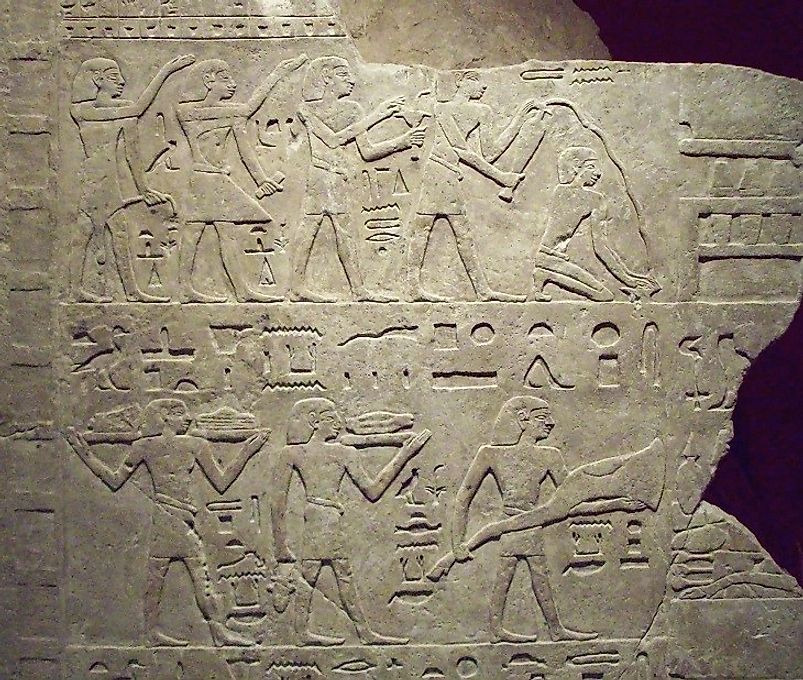The First Intermediate Kingdom Dynasties Of Ancient Egypt

5. Background and Initial Formation
The fall of the Old Kingdom of Egypt preceded the rise of the First Intermediate Kingdom Dynasties of Egypt. Many historians quote three primary reasons leading to the downfall of the Old Kingdom. The first is the fact that the last pharaoh of the Old Kingdom, Pepi II, ruled for an extended period of time from his childhood into his Nineties. Such a long lifespan saw Pepi II outliving many of his heirs, and his eventual death creating utter angst and confusion in the royal household regarding succession. The second fact is that the rise in power of provincial nomarchs occurred at this time in the kingdom, challenging the existence of the Old Kingdom. The third fact was related to the public unrest in Egypt arising from the droughts and famines triggered by the low water levels of the Nile during this time. All of these factors together accelerated the fall of the Old Kingdom, and allowed for the rise of the First Intermediate Kingdom Dynasties of Egypt in their wake. This period, which encompasses the timeline between 2181 BC and 2061 BC, is often marked as a ‘dark period’ in Egyptian history. It witnessed the rule of Egypt by the Seventh, Eighth, Ninth, and Tenth Dynasties, and part of the Eleventh Dynasty. Very little evidence of the rise and rule of these dynasties survives to this date. However, it is believed that this was a time when the powers of Egypt were concentrated at two different bases. Namely, Heracleopolis, in Lower Egypt, and Thebes, in Upper Egypt, were each constantly competing against each other to be the power center of all of Egypt.
4. Rise To Power And Accomplishments
The 7th and 8th dynasties of Egypt are almost overlooked by historians due to the presence of very little in the way of historical records describing the kings of this period and their respective foreign and domestic activities. The 7th Dynasty was possibly an oligarchy, co-ruled by several of the powerful officials of the former 6th Dynasty following the death of Pepi II. The rulers of the 8th Dynasty claimed to be the descendants of the 6th Dynasty kings, and these ruled Egypt from the capital at Memphis. The power of the 7th and 8th Dynasties waned with the rise of the Heracleopolitan Kings of the 9th and 10th Dynasties. The first ruler of the 9th Dynasty, Wahkare Khety I, is often judged by historians as a violent ruler who brought untold misery to the people of his kingdom. The power of the 9th Dynasty was consolidated by Kheti III, the third Heracleopolitan King. During this period, the nomarchs of Siut also enjoyed powerful positions in the country. The 9th and 10th Dynasties had 19 rulers who ruled for a period of nearly 94 years in Egypt. The rise of the Theban kings, who were possibly descendants of Inyotef, the nomarch of Thebes, ended the dominance of the Heracleopolitan Kings, and established the 11th and 12th Dynasties of Egypt.
3. Challenges and Controversies
During the reign of the Heracleopolitan Kings of the 10th Dynasty and the Thebian kings of the 11th Dynasty, Egypt was plunged into the darkness of a constantly raging civil war. The two rivaling dynasties would constantly wage wars against each other at both diplomatic and military levels. A feeling of terror and insecurity prevailed among the general population of the Nile Valley at this time, except for some regions, such as the Dakhla Oasis 220 miles west of the Nile, which remained largely peaceful. The absence of a centralized government also completely discouraged the ateliers of Memphis, whose work had earlier been given constant recognition by the kings of the Old Kingdom, and as a result these highly talented Memphian artisans suffered heavy losses.
2. Decline and Demise
The First Intermediate Period of Egypt ended with the rule of the first three Thebian kings later in the 11th Dynasty. The struggle between the Heracleopolitan Kings and the Thebian kings concluded when Mentuhotep II ascended to the Thebian throne in 2055 BC. He soon attacked Herakleopolis, the capital of the Heracleopolitan Kings, and toppled the last ruler of their 10th Dynasty. The beginning of the Middle Kingdom of Egypt was thus marked by the foundation of the 12th Dynasty by Mentuhotep II.
1. Historical Significance and Legacy
The art and architecture of the First Intermediate Period of Egypt is often perceived as sparse, clumsy, and unrefined. Very little evidence of artwork from this period exists to this date, and only one pyramid, possibly belonging to King Merikare, was known to have been built during this time. The highly skilled artisans of Memphis were largely ignored by the Heracleopolitan Kings and Thebian kings, and instead local artisans were assigned with the tasks of creating largely unfinanced artwork. However, one important feature of the Intermediate Period was the spread of the Pharaonic culture all across the country. During the Early Dynastic Period and the Old Kingdom, power was centralized. and the royals held their courts exclusively in a central capital in the country. However, the rise of provincial nomarchs during the First Intermediate Period established the Pharaoinic culture even well beyond the limits of the royal court, though these nomarchs did diminish the central authority of the pharaohs to some degree.











